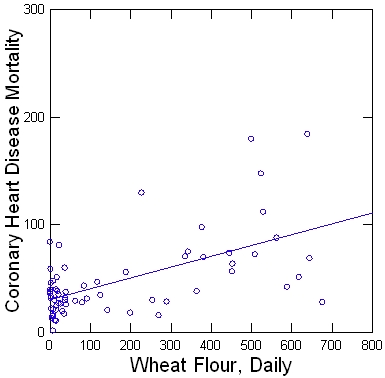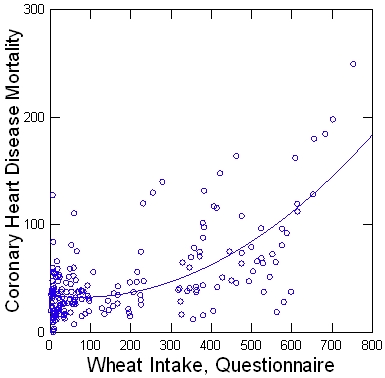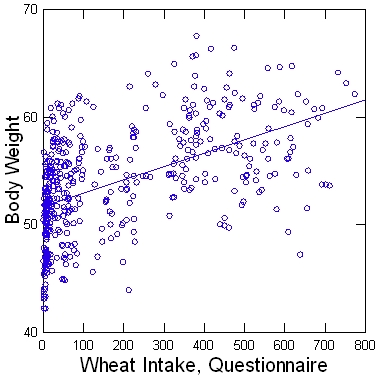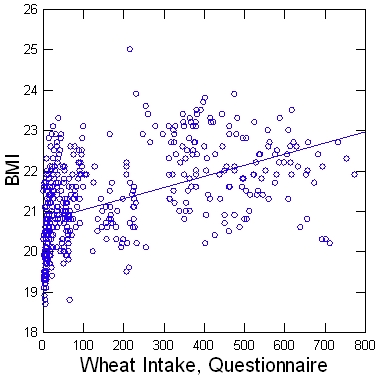If you've been following along with the previous China Study entries (and the wild drama that ensued), you know that I've been promising an entry on wheat for a while now, mostly because this little snippet snagged so many eyes:
Correlation between wheat flour and coronary heart disease: 0.67
That's a value straight from the original China Study data. Could the "Grand Prix of epidemiology" have accidentally uncovered a link between the Western world's leading cause of death and its favorite glutenous grain? Is the "staff of life" really the staff of death? Bwah ha ha.
Damning as it seems, a single unadjusted correlation isn't enough to make that leap. Actually, nothing in this post will be enough to make that leap, because A) it's epidemiological data and not a controlled study, and B) correlation isn't causation anyhow. You know the drill.
So my goal here isn't to prove anything about wheat. Mostly, I want to see if I can find a confounder that's creating a false association between wheat and heart disease in the China Study data. Something wheat-eating regions have in common that makes them more susceptible to ticker troubles. Because really, folks, this is serious business:And when we pluck out the wheat variable from the 1989 China Study II questionnaire - which has more recorded data - and consider potential nonlinearity, the outcome is even creepier:
Wowza! By the way, wheat flour also correlates significantly with hypertensive heart disease and stroke, but I'm mainly going to look at coronary heart disease in this post. (And although wheat looks like it could have a nonlinear relationship with heart disease, with the highest wheat eaters having disproportionately steeper rates than non-wheat eaters, I'm going to treat it as linear for the sake of this analysis. That way, the worst that'll happen is we'll underestimate the potential effect of wheat, which - for now - is better than overestimating it.)
Since I'm not trying to dissect our friend Campbell's claims anymore, I'll be using the China Study II data (from 1989) because it recorded more descriptive variables about diet and blood samples.* And because it's already available online. (Not that I don't love typing thousands of numbers onto my computer by hand. Three cheers for data-entry-induced carpal tunnel!)
*Quickie note: If you want to play with the China Study numbers yourself, I recommend not just using the "all vascular diseases" variable, because it includes rheumatic heart disease - a condition spawned by rheumatic fever and generally unrelated to diet. Lumping diseases with different etiologies together dilutes the strong correlations you can find by looking at each disease independently. Try checking out stroke (M065 STROKE), ischaemic heart disease (M063 IHD), and/or hypertensive heart disease (M062 HYPTENS) along with all vascular diseases (M059 ALLVASC).
Here's the problem with looking at wheat and heart health. Along with correlating pretty darn strongly with heart disease, wheat-eating regions boast a number of other factors possibly involved as well - some as protective agents and some as causative. For instance, wheat flour correlates significantly and inversely with:
- Plasma folate concentrations (and consequently, homocysteine status)
- Fish intake and DHA levels
- Yearly green vegetable consumption
- HDL cholesterol
- Vitamin C intake
- Height, weight, and BMI
- Blood pressure
- Latitude (as a possible marker for vitamin D status)
- Yearly milk intake
- Polyunsaturated fatty acid intake
On the bright side, China's wheat eaters are less likely to drown than the wheat-shunners (r = -0.68 for the youngsters under 34). Maybe they're all buoyant from celiac bloat.
And in case you're wondering, here are some heart disease risk factors (the ones Conventional Nutritional Wisdom likes to toss around) that don't positively correlate with wheat. That means we probably can't blame 'em for wheat's dirty deeds. Out of curiosity, though, I'll still include them in some of my models just to see how they behave in relation to wheat with heart disease.
- All meat intake (r = -0.35)
- Red meat intake (r = -0.30)
- Animal fat intake (r = -0.35)
- Saturated fat intake (r = -0.40)
- Total animal protein intake (r = -0.27)
- Total fat intake (r = -0.43)
- Fat as a percentage of total calories ( r = -0.41)
- Total cholesterol (r = -0.05)
- Apolipoprotein B (r = 0.02)
- Daily alcohol intake (r = -0.37)
So how do we untangle all these variables? I'm using two methods: multiple regression analysis and stratification. Multiple regression is a handy way of looking at two or more variables and seeing how each one behaves when the others are held constant, and stratifying data can work similarly by divvying up data into groups that share or exclude a certain variable. (For the stats junkies out there, I'm using ordinary least squares for the regressions, and I'm running each model two times: once with the data as-is, and once with any non-normally-distributed dependent variables transformed (via natural log) for more reliable statistical significance testing. I'm also checking for linearity between the variables before creating each model, since a nonlinear relationship will be underestimated with linear regressions.)
And for anyone not familiar with statistics terminology, here's a really quick rundown of what you need to know to understand the numbers in this post:
- r = the Pearson product-moment correlation coefficient between two variables. It can range from -1 to 1. When it's zero or close to zero, there's pretty much no relationship between the variables. When it's a negative number (like r = -0.50), there's an inverse relationship between the variables, meaning one increases as the other decreases. When it's a positive number (like r = 0.50), there's a positive relationship between the variables, meaning they increase and decrease hand-in-hand. The closer to -1 or 1 r is, the stronger the association. R can never prove cause and effect, though - it only indicates an relationship of some sort.
- beta = the standardized coefficient for each variable in the multiple regressions I'll be running. This is a lot like r, in the sense that it shows how well a specific variable is predicting the outcome (eg, heart disease) and also ranges from -1 to 1. But in the case of beta, we're also controlling for the effects of other variables, so this number tends to be more accurate than r.
- p = the probability that our results are just a fluke. P indicates how likely it is that we'd get a value of a test statistic that's as extreme (or more extreme) as the one we have based on chance alone. Having a p-value of less than 0.05 indicates a high level of significance and means that our results are pretty sound. The lower the number, the more confident we can be that we've got something legit.
- r-squared = percent of variance explained. This number shows what proportion of the outcome (eg, heart disease) can be explained by the variables in a particular model (eg, wheat and HDL cholesterol). The higher the number, the more successfully the variables are predicting the outcome. ("Predicting" is a misleading way of putting it, though, since we still aren't looking at proof of cause-and-effect - only a relationship.)
It's no secret that I'm less-than-enamored with wheat. We parted ways long ago (he got me allergic and then ran off with some floozy - classy, eh?). Nonetheless, I don't like pointing fingers where they shouldn't be pointed, so I'll entertain some alternative theories that could explain wheat's apparent association with heart disease.
- Folate deficiency. In northern China, about 40% of the population qualifies as folate deficient (compared to only 6% in the south) - a geographical trend that corresponds nicely with wheat consumption. Being low in folate tends to elevate homocysteine, which - you guessed it - is an independent risk factor for heart disease. So maybe it's not the wheat itself causing mischief, but the fact that low-vegetable, wheat-centered diets in China tend to breed folate deficiency and hike up homocysteine.
On top of that, in the China Study II data, wheat flour positively correlates (r = 0.30, p<0.05) with childhood death from neural tube defects - a category of birth defects often related to folate deficiency. Although the China Study data didn't document homocysteine levels (darnit), the 1989 data did measure plasma folate. That means we'll be able to test whether folate levels could be obscuring the true relationship between wheat and heart disease. - Vitamin D deficiency. For the most part, wheat-eating regions in China are in the northern half of the country - a hotspot for vitamin D deficiency, which is strongly linked to heart disease. Given the pretty convincing correlation between latitude and heart disease mortality, it's possible that vitamin D is playing a role in this mess. Are the wheat-eaters merely suffering from low levels of the ol' Sunshine Vitamin due to their unfortunate geographical placement, and getting more heart disease as a result? Sure seems possible.
- Low intake of DHA. In an earlier publication, Campbell and his crew already determined that fish and DHA intake appears protective against heart disease in the China Study data. Not too surprising, since DHA reduces blood viscosity and can lower other factors associated with heart disease (like triglyceride levels). And considering wheat-eating regions don't consume much seafood (r = -0.43 for daily fish intake), perhaps DHA deficiency - rather than wheat consumption itself - is to blame for higher rates of heart disease.
- Combo-abombo. Maybe a mix of low folate, vitamin D deficiency, and DHA deficiency are swirling together into a doomful vortex - some horrible, Bermuda-Triangle-esque zone of heart disease. A zone that just happens to overlay areas of wheat consumption.
- Unexpected mystery variable. If none of the above can explain the wheat-heart disease link, we've still got a verdant jungle of China Study variables to plow through. So plow we shall. I'll try running a number of common-sense models to see if I can find something that explains heart disease better than wheat alone.
Folate. Ah, theory numero uno! Like wheat, folate has a strong, statistically significant correlation with heart disease (r = -0.40, p<0.001), so what happens when we run a model using both folate and wheat as exposures? Initially, it looks like wheat clobbers folate as a predictor (beta = 0.59, p<0.001 versus beta = -0.06, p = 0.39) - which would suggest that, although China's wheat-eaters tend to have lower folate levels, folate deficiency itself isn't enough to explain the link with heart disease.
But I'm not ready to dismiss this one just yet. As often happens with plasma measurements and health conditions, folate may have a nonlinear relationship with heart disease - which means multiple regressions (of the linear variety) won't show the full picture. Indeed, when I make a scatter plot for folate levels and coronary heart disease, it looks like a bit of a curve emerges, with folate being most strongly associated with heart disease when the county average dips below 10 micrograms per liter (or thereabouts). Above that, the correlation is far less dramatic.
So how do we deal with this statistical monkey wrench? For starters, I tried transforming the folate data to make it more suitable for linear regressions, but that didn't do diddly squat to the results: The numbers were beta = 0.58, p<0.001 for wheat and beta = -0.06, p = 0.31 for folate. So then I tried stratifying the data based on "low" and "high" folate levels (10 or less micrograms/liter versus 10.1 or more micrograms/liter), but both subgroups continued showing wheat as strongly and significantly correlated with heart disease while folate was off the hook.
Just to cover my bases (and because I'm a stubborn son-of-a-gun), I kept playing with the numbers for a while longer to see if I could excavate anything new. Nope. Bottom line: It looks like wheat is predictive of heart disease whether or not folate levels are low, whereas folate is mostly predictive of heart disease only in the presence of high levels of wheat consumption.
So, theory #1 doesn't pan out. Bugger. But bear in mind, we're using folate mostly as a marker for elevated homocysteine, so these results don't mean that homocysteine itself isn't playing a role. Other causes of high homocysteine, such as B12 deficiency, weren't documented in the China Study data. So this is an issue that'll have to remain annoyingly unresolved. Another bugger!
Onto the next theory: latitude. Could the folks living in northern wheat-eating regions have lower vitamin D levels, leading to more heart problems - and creating a false link between wheat and cardiovascular disease? I admit, this was my favored theory after folate, but it ain't holdin' water. When I run wheat and latitude together as potential contributors to heart disease, wheat remains strongly predictive (beta = 0.65, p<0.001), while latitude diminishes (beta = -0.01, p=0.96). It's pretty clear that the raw correlation between heart disease and latitude (which is 0.43, p<0.01) is just an echo of the relationship between heart diseases and wheat-eating regions, which are typically northern.
Okay, so that's two strikes for Denise's heart disease theories. What about fish and DHA? Are the wheat eaters suffering due to their fishless (and low-in-DHA) diets rather than from wheat itself? Alas, it doesn't look likely. When I run these things together as exposures for heart disease, wheat stays strongly predictive (beta = 0.68, p<0.001) while the fishies do not (beta = 0.08, p = 0.47). Likewise, DHA teeters out into statistical insignificance (beta = 0.06, p = 0.30) when used in a model with wheat.
(Wait, I know what you're thinking! "Why does it look like fish and DHA contribute positively to heart disease?" It's because many of the fish-eating regions are more industrialized, and - in the absence of wheat - the fish-heart disease relationship is confounded by other factors like more desk work, more smoking (especially manufactured cigarettes), less physical activity, more vegetable oil consumption, and so forth. When we add some more variables to the model that take away the "city effect" associated with fish - such as apo-B, tobacco use, or percentage of the population employed in agriculture - then both fish and DHA turn inverse again. Although wheat, it should be mentioned, stays rock-steady in its high coefficient and statistical significance.)
Other stuff
Milk. Is moo juice a cardiovascular foe obscuring the relationship between wheat and heart disease? Probably not, according to the data - which isn't surprising, given how few counties even drink the stuff. When running daily milk intake alongside wheat intake, wheat keeps its positive correlation (beta = 0.67, p<0.001) and milk actually turns a bit inverse, though not significantly so (beta = -0.07, p=0.47). No model shows a significant association between milk and cardiovascular disease, so I'm crossing this one off the list of potential confounders.
Blood pressure, BMI, corn, millet, sorghum, rice, added animal fat, added vegetable fat, total fat, total animal food, total carbs, total protein, percent of calories from animal protein, and all the smoking/tobacco variables I tried became statistically nonsignificant (in relation to heart disease) when thrown into a model with wheat.
Income is positively associated with heart disease when wheat is held constant, but it still doesn't put a ding in wheat's association with heart disease.
Models with more variables
So apparently comparing wheat + one other independent variable isn't enough to explain the Wheat Effect. Not even a little bit. But maybe, just maybe, a bigger combination of variables will do the trick. Perhaps wheat-eating regions just host a collection of heart-harming factors (low folate, low vitamin D, low EFAs, and so forth) that, together, are more powerful predictors of disease than the variable wheat.
Here are the variables I'm interested in looking at. Some could be causative and some could be preventative:
- Wheat consumption
- Corn consumption
- Millet consumption
- Rice consumption
- Total blood cholesterol
- LDL cholesterol
- HDL cholesterol
- Apolipoprotein-B
- DHA levels
- Folate levels
- Latitude
- Added vegetable oil
- Blood pressure
- Weight
- BMI
- Total fat intake
- Total monounsaturated fat intake
- Total polyunsaturated fat intake
- Total saturated fat intake
- Percent of calories as fat
- Percent of calories as carbohydrates
- Total animal protein intake
- Total plant food intake (by weight)
- Total animal food intake (by weight)
- Green vegetables (daily, not yearly)
- Vitamin C intake
- Total sodium intake
- Poultry consumption
- Egg consumption
- Red meat consumption
- All meat consumption
- Fish consumption
- Dietary cholesterol intake
- Percent of the population currently smoking
- Percent of the population who have ever smoked tobacco
- Percent of the population smoking manufactured cigarettes
- Percent of the population pipe smoking
- Percent of the population smoking cigars
- Percent of the population working in industry (typically less physical activity)
- Percent of the population working in agriculture (typically more physical activity)
Incidentally, one model had the best fit out of all the others for explaining heart disease:
- Wheat consumption (beta = 0.62, p<0.001)
- Apolipoprotein B (beta = 0.38, p<0.001)
- Total cholesterol (beta = -0.22, p<0.05)
Anyway, here's the important point. No matter what variables I adjust for, I can't make the correlation between wheat flour and heart disease go away. Sorry, wheat! Neener neener.
Cardiovascular disease: The only "Western" problem without "Western" risk factors
Here's a mystery for ya.
In the China Study data, most Western diseases (such as breast cancer, colon cancer, lung cancer, and diabetes) are concentrated in areas that share some key characteristics: more industrial employment, less agricultural work, greater population density, and often higher levels of schooling. Folks here eat more processed starch and sugar, use more polyunsaturated vegetable oils, chug down more beer, smoke more manufactured cigarettes, and typically get less physical activity than their neighbors in pastoral communities.
In other words, the Western-disease-prone-regions are like baby Americas - slowly waddling, diapered and naive, towards the motherly lap of disease.
Most likely, these Western ailments aren't spawned from a single food or activity, but from a tragic mix of diet choices, lifestyle habits, and environmental factors. For problems like breast cancer and colon cancer and lung cancer, it's pretty easy to see what the matrix of risk-raisers are from looking at the data: It's the same combination of things spurring disease in Western nations.
But oddly enough, this isn't the case for heart conditions. The factors shared by other Western illnesses are not, in most cases, associated with heart disease in this data set. If you've read some of the earlier China Study posts, you might remember that I took issue with Campbell's disease-clustering strategy because heart disease doesn't fit cleanly with the "diseases of affluence" group, despite his insistence on sticking it there anyway. Unlike the other Western problems, heart disease isn't associated with eating more sugar, working in industry, drinking more alcohol, using vegetable oils, having higher apo-B levels, or any of the other variables uniting the Western diseases and mirroring the traits common to industrialized countries.
What's the only thing heart-disease-prone regions have in common with Westernized nations? That's right: consumption of high amounts of wheat flour.
Food for thought. Kinda spooky.
Wheat eaters: fatter with fewer calories
Here's some more weirdness. In both China Study I and II, wheat is the strongest positive predictor of body weight (r = 0.65, p<0.001) out of any diet variable. And it's not just because wheat eaters are taller, either, because wheat consumption also strongly correlates with body mass index (r = 0.58, p<0.001):
How odd! This aligns with a post Stephan Guyenet at Whole Health Source wrote about wheat consumption and obesity in China, speculating that wheat might wreak metabolic havoc wherever it goes - a trend that becomes apparent when comparing similar populations of wheat eaters and non-wheat eaters, such as in China. But perhaps there's some confounding going on. What about calorie intake? Are the wheat eaters just scarfing down more food in general, leading to higher weight regardless of wheat consumption? Doesn't look like it. Running wheat and calorie intake together as predictors with BMI as the outcome, wheat takes the weight-gaining gold:
- Wheat: beta = 0.56, p<0.001
- Calorie intake: beta = 0.13, p = 0.19
Out of curiosity, I ran a stepwise regression on a bunch of relevant variables to see what combination would best predict BMI. (In statistics, stepwise regression is a really cool, but sometimes totally misleading method for building a statistical model. It involves adding (or winnowing away) variables one by one based on how they behave together and contribute to the outcome - BMI, in this case - until you've got a model where each variable offers significant variation and the highest possible percent of explanation (represented as r-squared). Unfortunately, since this process is automated and computers usually don't understand the whole "biological plausibility" thing, you can wind up with weird models that don't make sense in the real world. Nonetheless, it can be a worthwhile method if used with caution.)
Setting BMI as the outcome, I chose the following variables as potential exposures:
- Total calories
- Total fat
- Total carbohydrates
- Total plant food
- Total animal food
- Total plant protein
- Total animal protein
- Total monunsaturated fat intake
- Total saturated fat intake
- Total polyunsaturated fat intake
- Red meat
- All meat
- Fish
- Poultry
- Eggs
- Wheat flour
- Corn
- Millet
- Legumes
- Starchy tubers
- Green vegetables (daily, not yearly)
- Agricultural employment
- Industrial employment
The best-fitting model for predicting BMI (at 95% confidence)? Drum roll please. Three variables made the cut.
- Eating more wheat flour (beta = 0.48, p<0.001)
- Eating more polyunsaturated fat (beta = 0.44, p<0.001), and
- Eating fewer green vegetables (beta = -0.29, p<0.01).
Interesting, eh? All animal foods and total dietary fat, by the way, were completely insignificant in terms of BMI.
Of course, there could be other variables involved that the China Study didn't cover. Were the higher-BMI folks also more heavily muscled (perhaps from more physical labor), increasing their body weight but not body fat? Are the wheat eaters, some of whom are ethnic minorities in China (especially Turkic and Mongolian), genetically "bigger" than the Han Chinese? There are plenty of unknowns, and alas, no way to clarify them based on this data.
I guess we'll leave it as a question mark for now.
Grain damage: Do other studies back it up?
But don't those peer-reviewed, scientific studies tell us wheat is healthy? Alas, the vast majority of studies on grains - especially wheat - showcase at least one of the following problems:
- They look at the effects of whole grains versus refined grains - not whole grains versus the same diet with no grains at all.
- Study subjects increase their consumption of whole grains, and this displaces some portion of yuckfoods (processed junk, white-flour products, sugary things, and so forth). As a result, it's hard to tell whether any health perks are due to the addition of whole grains, or from the reduction of truly-awful-for-you foods. This is particularly true in studies that scout out disease patterns in populations rather than controlled studies that measure specific changes that occur with the addition of whole grains.
- They don't adequately account for other factors that often accompany whole-grain consumption, like a greater level of health consciousness, more exercise, other positive diet choices, and so forth.
As you might guess from the title, this study examines the effects of diet on the development of atherosclerosis - AKA hardening of the arteries. The researchers took cholesterol-infused rabbit food and supplemented it with liquid corn oil (yuck), hydrogenated corn oil (double yuck), wheat germ (mystery murderer?), and sucrose (sweet poison!). Sorry, I dig hyperbole. Anyway, part of the goal was to create an experiment testing the hypothesis that "the geographic differences in the incidence of coronary disease might be related to selective hydrogenation of polyunsaturated fatty acids or to degermination of cereals."
So now, the moment of truth: Which group had the most severe atherogenesis? Perhaps the one fed the nasty hydrogenated oil, as hypothesized? Ladies and gentlemen, place your bets. From the article:
The most severe atherogenesis occurred in the animals on the wheat germ diet.Was it a fluke? Probably not:
In an earlier study, we maintained 5 groups of 5 rabbits each for three months on 500 mg of cholesterol daily and rabbit chow supplemented with different fats or with wheat germ. Here also, the animals on the wheat germ diet showed a significantly greater degree of atheromatous lesions than the animals on rabbit chow plus 20% corn oil, cottonseed oil or hydrogenated cottonseed oil, whereas no significant difference was found between the various fats.
So what made the wheat germ contribute to atherogenesis? The researchers state that it's "difficult to speculate" about the mechanism, which is a scientific way of saying "We dunno." They suggest the extra dietary protein from wheat germ could be the cause, but from the literature I've skimmed so far, it looks like plant proteins don't have much effect on bunnies (although animal protein does).
Of course, rabbits are truly terrible models for anything that happens in the human body. They're hardcore herbivores. A mere billowing of the wind is practically enough to spike their cholesterol. But what explains the specific effect of wheat germ on their poor arteries? Could this have implications for humans?
My answer: It's "difficult to speculate."
Other studies
Prefer human studies? Me too. Here's one that initially looks totally irrelevant but is actually pretty interesting: Flaxseed and cardiovascular risk factors: Results from a double blind, randomized, controlled clinical trial. (This also a stellar example of why it's important to read full-text articles instead of just abstracts, which often don't tell you diddly about the stuff you want to know.)
This particular study charted the effects of flaxseed on adults with high cholesterol. One group got food with ground flaxseed; the other group got food with added wheat bran. Other dietary elements were the same. (Low fat, low cholesterol. Fun times!)
The results? Ye Olde Flaxseed Group did pretty well: Compared to their baseline measurements, these folks had lower insulin, lower blood glucose, lower C-reactive protein (a marker for inflammation), and better insulin sensitivity (as calculated by HOMA-IR).
But poor Wheat Group was less fortunate. Since the study was about flaxseed, the results of wheat aren't specifically discussed, but check out "Table 4″ in the link above to see the numbers for yourself. The wheat-bran eaters had a 14.9% increase in insulin resistance (calculated by HOMA-IR) and a 9.3% increase in C-reactive protein. In other words, they lost some insulin sensitivity and gained some inflammation - two risk factors for heart disease. Hmm. Was the wheat bran to blame? Some other element of the control diet? It's impossible to say for sure based on this study, but considering the wheat group's adverse effects were more dramatic than the flaxseed group's benefits, it seems a little suspect.
(A rather abrupt end of part one! The next post will have some more studies and speculations on potential mechanisms for wheat as causative of heart disease.)








Reader Comments
to our Newsletter